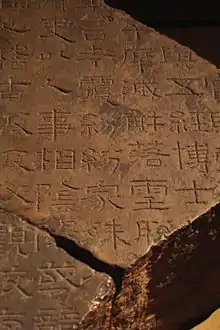Xiping Stone Classics
The Xiping Stone Classics (Chinese: 熹平石經) are a collection of Han dynasty stone carved books on various Confucian classics. They were set up at the Imperial Academy outside Luoyang in 175–183. The Classics were created by Cai Yong and a group of affiliated scholars who "petitioned the emperor to have the Confucian classics carved in stone in order to prevent their being altered to support particular points of view."[1]

Around 200,000 characters were inscribed on 46 stelae of the seven classics recognized at the time: the Book of Changes, Book of Documents, Book of Songs, Book of Rites, Spring and Autumn Annals, Classic of Filial Piety and Analects. Only a few fragments of these tablets have survived.[2][3][4]
The stele were about 2.5 meters in height and a meter in width. Scholars, which included Ma Midi, Han Yue, Lu Zhi, Yang Bao, Li Xun, and Zhao You besides Cai Yong, would write text onto the stone using cinnabar, which was then engraved. When completed, 28 stela containing the Changes, History, Chunqiu, and the Gongyang commentary, were arranged on the western side of a roughly "U" form. The 15 stela with the Ritual, including the names of Cai Yong and Ma Midi, were placed on the southern side, while the 5 stela containing the Analects were on the eastern side. Scholars could then take rubbings, besides studying the texts.[5]
See also
References
- "The Xiping Stone Classics from the National Library of China". World Digital Library.
- Wilkinson, Endymion (2000). Chinese history: a manual (2nd ed.). Harvard Univ Asia Center. pp. 439, 475. ISBN 978-0-674-00249-4.
- "Remains of the Old Luoyang". CCTV-9. 26 August 2011.
- Xiping Stone Classics (熹平石经) (in Chinese)
- de Crespigny, Rafe (2017). Fire over Luoyang: A History of the Later Han Dynasty 23-220 AD. Leiden: Brill. pp. 382–384. ISBN 9789004324916.
External links
| Wikimedia Commons has media related to Xiping Stone Classics. |
- Stone fragments from the Xiping reign in the Chinese stone rubbings database at East Asian Center for Informatics in Humanities, Kyoto University, including two fragments of the classics: 61A and 61B.